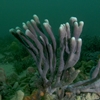General Description
A sandy to purple sponge species with encrusting form. Size of about 30 cm.
Biology
These sponges only incorporate sand and broken spicule fragments into their skeletons, which have been drawn in with the incurrent of seawater.
Habitat
Reef areas, to depth of 5 m.
Sponge gardens
Reefs
Distribution guide
Port Phillip in Victoria.
Species Group
Depth
Water Column
Max Size
30 cm
Diet
Plankton or particles
Commercial Species
No
Global Dispersal
Recorded in Australia
Species Code
sp. MoV 6706
Identify
Conservation Status
- DSE Advisory List : Not listed
- EPBC Act 1999 : Not listed
- IUCN Red List : Not listed




